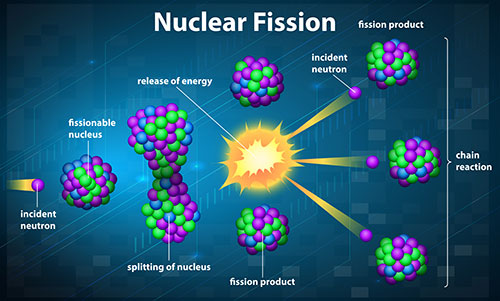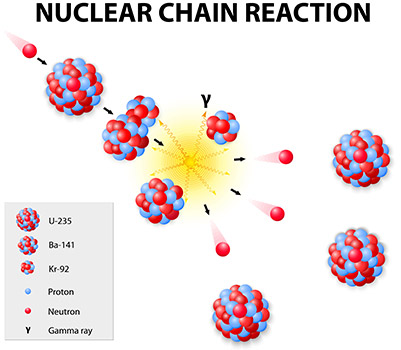Learn
Nuclear Fission
Nuclear fission occurs when a heavy nucleus splits into more stable, medium-mass nuclei. It releases an extreme amount of energy during the process. Fission can occur spontaneously or when nuclei are bombarded by neutrons.
When plutonium-239 is bombarded with neutrons, a plutonium nucleus can capture one of the neutrons, making the nucleus very unstable and causing it to split. As the plutonium nucleus splits into two medium-mass nuclei, it releases neutrons. With the release of the neutrons, the mass of the products is less than the mass of the reactants. The mass difference is converted into energy. The atomic bombs used by the US to end World War II were powered by nuclear fission.
Watch the video Nuclear Fission (3:08) to learn more. Login instructions.

To see a larger version of this image of nuclear fission, click here.
Chain Reaction
During the nuclear fission process, as the nuclei are bombarded by neutrons, they release more neutrons, creating a chain reaction. A chain reaction is a series of repeated fission reactions caused by the release of additional neutrons in each reaction. The material that starts the chain reaction is also one of the products and can start another reaction.
Watch the following videos to see this process:
- A Fission Chain Reaction (2:45) Login information.
- The Chain Reaction: Spliting the Uranium Atom (4:16)

To see a larger version of this image of a chain reaction, click here.
Nuclear Fusion
Nuclear fusion occurs when low-mass nuclei combine to form a heavier, more stable nucleus. Fusion reactions release more energy than fission reactions. In order for fusion to occur, the nuclei must have enough kinetic energy and get close enough to overcome the natural repulsion of the overall positive charges. As the temperature of the particles increase, the kinetic energy also increases. Once the temperatures reach in the millions of degrees Celsius range, the nuclei will have great enough kinetic energy for nuclear fusion to occur. This nuclear fusion occurs in the cores of stars.
Watch the video Nuclear Fusion (3:46) to learn more. Login instructions.

To see a larger version of this image of nuclear fusion, click here.
Proton-Proton Reaction
The diagram below depicts the fusion process called proton-proton reaction. This is the same process that a star the size of our sun goes through.
To learn more about proton-proton reactions, watch the following videos:
Review
Watch the video Nuclear Chemistry Part 2: Crash Course Chemistry #39 (11:16) to learn about real world applications of nuclear fission and nuclear fusion. Login information.

